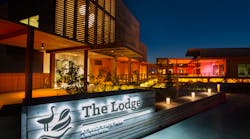The project is part of the pan-European BLISS (Better Lighting in Sustainable Streets) project, which aims to help shape an energy-efficient street-lighting strategy for Europe.
The BLISS project is designed to evaluate a wide range of street-lighting options, and currently includes projects in the UK, Netherlands, Belgium and Germany. It is part-funded by the European Regional Development grant via the North West Europe INTERREG IVB investment program.
Rory Lingham, Assistant Director (Engineering) with the Council, explained: “The key to our proposal is to develop a range of socially-acceptable, energy-reducing solutions while considering their wider social and economic impacts in terms of public perception, crime, accident and economic regeneration. We believe we can create new low-energy lighting solutions which offer greater comfort, safer environments and improve everyday urban life.”
Coronation Drive Estate
The purpose of the Coronation Drive element of the project was to create an environment where different types of street lighting could be easily compared with each other simply by walking from one street to another. The key comparisons, from both a performance and perception point of view, were between new LED lighting and more traditional light sources.
To that end, one street uses low-pressure sodium (SOX) light sources, another uses high-pressure sodium (SON) and a third uses Philips CosmoPolis ceramic-discharge metal-halide lamps. In addition, Philips SpeedStar LED street lanterns have been installed in three streets, each with different color temperatures, namely 3000K, 4000K and 5600K.
“The new lighting is of a much higher standard,” said Lingham. “It enables people to recognize colors and see objects much more clearly than the lighting which was there before.”
Tithebarn Road
Tithebarn Road is a 1000-m stretch of 60 mph (96 kph) road that links two areas of St Helens. The road was originally lit by 23 x 8m columns using a mixture of low- and high-pressure sodium light sources.
The older lighting has now been replaced with 20 x 10m columns using Philips SpeedStar LED lanterns. The higher light output of the new lanterns has enabled fewer, taller columns to be used to maintain the required light levels and light distribution. In addition, controls have been introduced to dim the lighting to 50% between midnight and 6am.
“We believe this was the first full-scale demonstration of the SpeedStar lighting in the world. The quality of the lighting is much improved and that’s a real advantage to motorists. It’s now much easier to see other vehicles and pedestrians on the road,” Rory Lingham noted.
As a result of these changes, energy consumption for this stretch of road has been reduced by 21%, saving approximately 1,145 kg of carbon emissions per annum. The Council will also benefit from a considerable reduction in maintenance costs due to the much longer life of the LED light sources.
“The BLISS project has resulted in considerable reductions in energy consumption. Moreover, the public has shown great acceptance of what we’ve done. The survey has shown that around 78% prefer the whiter light of the LEDs. And, because we are also getting 25-50% energy savings it makes sense to install LEDs in these sorts of areas,” Rory Lingham concluded.






